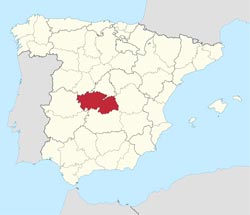Toledo in Toledo

The province of Toledo is situated in the region of Castilla-La Mancha and shares its borders with two other provinces in the same region, Cuenca and Ciudad Real as well as the region of Extremadura, Comunidad de Madrid, and Ávila in Castilla y León.
The province is home to 703,772 souls distributed on 204 municipalities. Toledo covers an area of 15,368 km2 and has a average height of 590 MASL; the highest point in the province is Corocho de Rocigalgo which, with its height of 1,449 MASL is considered ‘the roof of Toledo’. The stunning views from this point over the Cabañeros National Park lure many a visitor to make their way up there.
 The river Tagus runs through the province from east to west. The Tagus is one of the most important rivers in Spain, and on its course through Toledo it is fed by other large rivers such as the Albarche, the Tiétar, and the Guadarrama. Toledo has mountain ranges to the south and the northwest; in between is a great plain with gently rolling hills.
The river Tagus runs through the province from east to west. The Tagus is one of the most important rivers in Spain, and on its course through Toledo it is fed by other large rivers such as the Albarche, the Tiétar, and the Guadarrama. Toledo has mountain ranges to the south and the northwest; in between is a great plain with gently rolling hills.
The capital of Toledo, – Toledo – is situated quite centrally in the province and it has 85,811 inhabitants. The river Tagus crosses through the city with the historic district sitting on the right bank, just where the river curves sharply. The city was an important Carpathian population centre even before the Romans hit the Peninsula and conquered Toledo in 193 BC.
After the Germanic invasion, it became capital and then the ecclesiastical head quarters during the Visigoth rule. In 711,
Toledo was conquered by the Muslims, and it is still today known as ‘the city of three cultures’ as it was populated by Christians, Jews and Muslims for several centuries. However, in 1085 Toledo finally fell into Christian hands under the rule of Alfonso VI. The court of Carlos I made the city its main base, which has also led it to boast the nickname ‘The Imperial City, However, in the 16th century the war of the three communities of Castilla-La Mancha led the king to move the court to Madrid, throwing the city into a decline which was not helped by the financial crises of the times.
When the Civil War started, Toledo was included in the republican zone; however, the city’s citadel was home to the Infantry Academy, and a group of some 1,950 rebels consisting of military personnel, police officers and their families barricaded themselves there and resisted the government forces from 21st July to 27th September 1936, when Franco’s troops came to their rescue and conquered Toledo. This siege made great propaganda for the Franco government in subsequent years, and the citadel, which had been completely destroyed during the siege, was reconstructed in its totality.
The climate in Toledo is classified as semi-arid. The scarce precipitations mainly fall in spring and autumn with drought in summer combined with drastic changes in temperatures between day and night. Frost is not unusual in winter, although not as frequent as in the rest of the region; the temperatures in summer, however, are extremely high, often over 40ºC; in 2007, Toledo was the sunniest city in Spain with 3,040 hours of sun. The economy of Toledo is mainly based on the services sector, and the city is a popular tourist destination; the citadel is one of its main attractions, and the city’s traditional sword industry, which dates all the way back to Roman times, has made its mark on the souvenir trade: Most visitors who want to keep a memento of Toledo, or give one to friends or relatives, choose a sword or a knife produced from Toledo steel.
This steel is historically known for being unusually hard; the city has been a sword making, steel working centre since about 500BC. It came to the attention of Rome when Hannibal used in the Punic Wars, and soon became standard weaponry for the Roman legions. Toledo's historic centre, a main attraction for visitors, was named a World Heritage Site in 1986.


